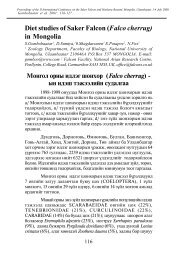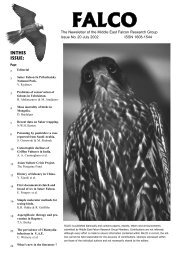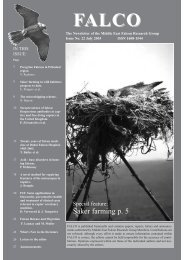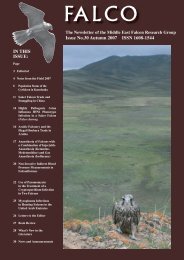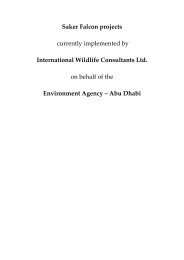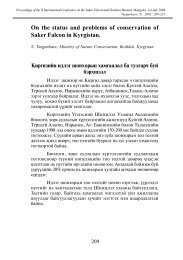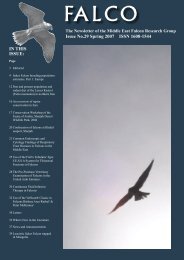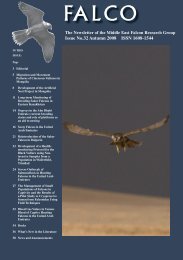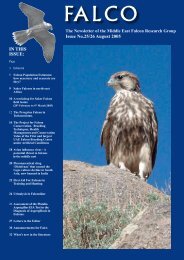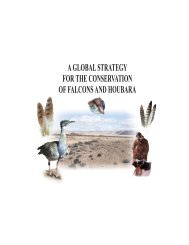Falco 27 - International Wildlife Consultants Ltd.
Falco 27 - International Wildlife Consultants Ltd.
Falco 27 - International Wildlife Consultants Ltd.
- No tags were found...
You also want an ePaper? Increase the reach of your titles
YUMPU automatically turns print PDFs into web optimized ePapers that Google loves.
The Saker <strong>Falco</strong>n in Bulgaria: Past, Present and FutureDimitar Ragyov & Vesselina ShishkovaAffiliation:Institute of Zoology , Bulgarian Academy of Science, Sofia1000 blv. Car Osvoboditel 1, Bulgaria.E-mail: ragyov@abv.bgSummaryWidespread and numerous in the past, the Saker <strong>Falco</strong>nin Bulgaria is presently on the edge of extinction. Thespecies’ population collapsed between 1930 and 1960under the influence of the following factors: habitatloss; decrease of European Souslik; pesticide andfertilizer use; poaching (shooting) and use of poisonbaits. Another factor presently having a strong negativeinfluence is nest robbery.In 2006 the Bulgarian Academy of Science (BAS)and <strong>International</strong> <strong>Wildlife</strong> <strong>Consultants</strong> <strong>Ltd</strong>. (IWC <strong>Ltd</strong>)with the financial contribution of the EnvironmentalAgency of Abu Dhabi (EAD) will initiate a researchand conservation project “Saker <strong>Falco</strong>n in Bulgaria andSoutheast Europe”. The main objective of the project isto stop the decline in Saker population in the region.IntroductionGeographically Bulgaria is close to the westernmostlimit of the Saker <strong>Falco</strong>n (<strong>Falco</strong> cherrug) distributionrange. Located on the Balkan Peninsula in SE Europe,the country has a varied relief and a wide range ofhabitats, including steppe, old natural forests, rockymassifs and high mountain meadows (over 2500 m).The lowest part of the country is the Black Sea coastand the highest point is “Musala” peak at an altitudeof 2925 m.The distribution ranges of Saker, Lanner (<strong>Falco</strong>biarmicus) and Peregrine <strong>Falco</strong>ns (<strong>Falco</strong> peregrinus)overlap in Bulgaria. The Gyrfalcon (<strong>Falco</strong> rusticolus)was a very rare, accidental winter visitor in the past,whilst Barbary <strong>Falco</strong>n (<strong>Falco</strong> pelegrinoides) ismentioned in the literature as “probable” species in thecountry (Nankinov, 1992) but there is no certain recordavailable. All the large falcons within the territory ofBulgaria are rare species with serious threats to thesurvival of their populations.Past statusSaker <strong>Falco</strong>n population decline in BulgariaNumerous and widespread in the past, the Saker <strong>Falco</strong>nis presently on the edge of extinction in Bulgaria. Atthe end of 19 th Century and the beginning of the 20 thCentury, according to different authors the Saker isdescribed as: “very common species. More than fivenests found in a few days only” (Elwes & Buckley1870 in Michev & Petrov, 1985); “frequently seen inthe forests of Dobrudja” (Sintenis, 1877 in Michev &Petrov, 1985); “besides Black Kite and Marsh Harrier,the Saker is the most widespread bird of prey species inDobrudza and is abundant around the Danube marshesand hill forests” (Floericke, 1918); “common breederaround Danube river” (Patev, 1950). Based on thesestatements, we consider that at the beginning of the 20 thCentury at least 2000 pairs of Saker <strong>Falco</strong>ns inhabitedthe Bulgarian territory.Nowadays estimates of Saker <strong>Falco</strong>n numbers are:2–6 pairs (Burfield & van Bommel, 2004), 4-10 pairs(Birds Of Prey Protection Society, 2005) and 8-12pairs (Nankinov et al., 2004)Many of the causal factors for the population decline aresimilar to those operating elsewhere in the world rangeof the Saker <strong>Falco</strong>n, but some factors are specific toBulgaria. There are two important events in Bulgaria’scontemporary history, World War II and the changeof regime in 1989. These events not only affectedthe political situation but also drastically changed theeconomy of the country, the lifestyle of the people andinevitably had a significant influence on wildlife aswell.Agricultural practices were altered after World War IIin that pastoralism declined rapidly and ‘high farming’started. The existing Saker hunting habitats (i.e.,wide open spaces with low grass cover) were eitherleft uncultivated so that the wild grasses grew tall,reducing the availability of ground dwelling prey forSakers, or they were replaced by massive agriculturalmonocultures. Intensive agriculture is associatedwith the mass extermination of rodents, includingSousliks (Spermophilus citellus), an important preyspecies for Saker <strong>Falco</strong>ns. Pesticides and fertilizerswere extensively used in intensive agricultural systemsduring the decade 1970-80. Their effect on wildlifewas significant and numerous wild animals were founddead after these chemicals were applied using aircraft.The widespread use of poison baits against predatoryanimals (mainly strychnine) took place between1930-70, and during this period the terms “harmfulmammals” and “harmful birds” came into fashion.Almost all birds of prey, crows and predatory mammalswere considered harmful for the “socialist people’sagriculture” and therefore they were poisoned or shotat every opportunity. There has even been a furtherincrease in the shooting of birds of prey since 1980 ashunters in Bulgaria had a legal duty to kill birds of prey.As a result of these factors, sometime in the period 1930-60 the Saker <strong>Falco</strong>n population in Bulgaria collapsed.



